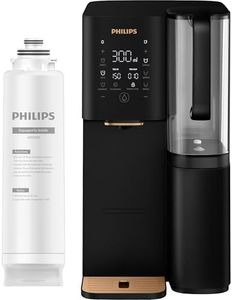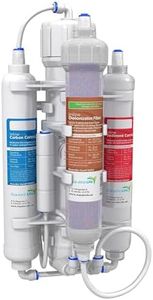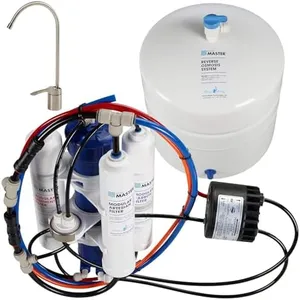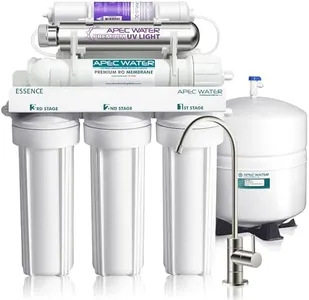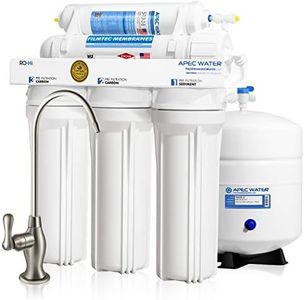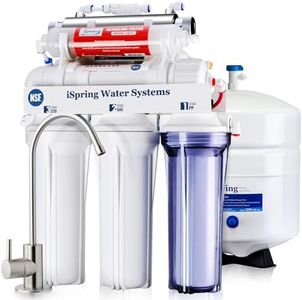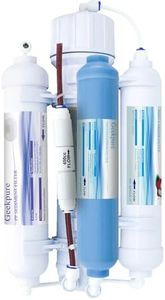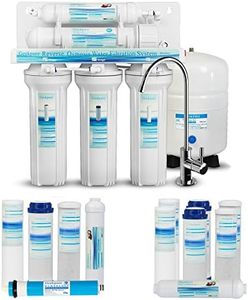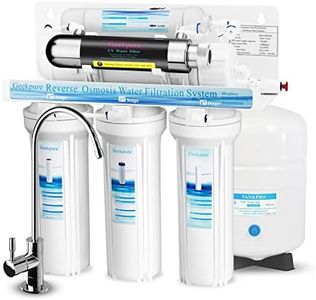We Use CookiesWe use cookies to enhance the security, performance,
functionality and for analytical and promotional activities. By continuing to browse this site you
are agreeing to our privacy policy
10 Best Reverse Osmosis Systems
From leading brands and best sellers available on the web.Buying Guide for the Best Reverse Osmosis Systems
Choosing a reverse osmosis (RO) system for your home is a smart move if you're concerned about water quality. These systems use a special membrane to filter out a wide range of contaminants, providing clean, great-tasting water. With so many options out there, it's important to consider your water needs, available space, and the features that matter most to you. Understanding the primary specifications can help make your decision much easier and ensure you select a system that fits your household’s usage, water conditions, and lifestyle.Filtration StagesFiltration stages refer to the number of steps water passes through in the purification process, usually ranging from three to seven. Each stage targets different contaminants—like sediment, chlorine, heavy metals, and more. More stages often mean better filtration, but also more maintenance and a higher cost. If your water is already decent or only has specific issues, fewer stages might be fine. For those with very hard or heavily contaminated water, go for systems with more stages. Focus on what your water test results say to guide your choice.
Membrane Type and QualityThe membrane is the heart of any RO system, as it decides which impurities are removed. Higher-quality membranes can filter tinier particles and last longer. Standard membranes handle most residential needs, while premium or high-rejection membranes are great for those seeking even greater purity or dealing with especially poor water sources. If you need the purest water possible, look for a high-quality membrane, but for general use, a standard one suffices.
Water Output (Gallons Per Day)Water output, typically measured in gallons per day (GPD), tells you how much filtered water the system can produce in 24 hours. Lower-output systems (about 50 GPD) work well for small households with modest water use. Higher-output units (75-100+ GPD) suit larger families or homes with greater daily drinking and cooking water needs. Consider how much purified water your household uses to decide what output suits you best.
Tank Size and TypeMost RO systems include a storage tank, as filtration is a gradual process. Tank sizes range from small (3 gallons) to larger capacities (6-10 gallons). Smaller tanks save space and are fine for occasional use, while bigger tanks ensure you always have clean water available, even during peak usage. If space is tight under your sink, a compact tank is better; otherwise, a larger tank can provide more convenience for families.
Filter Lifespan and ReplacementFilters and membranes need regular changing to keep your system working well. Some systems require replacements every six months, while others can go longer between changes. Less frequent replacements mean less hassle and lower ongoing effort. Check both the frequency and ease of replacement before choosing—some people prefer systems that are simple and quick to maintain, especially if they don’t want to deal with frequent filter changes.
Efficiency and Waste Water RatioRO systems create some waste water as they filter. The waste water ratio (e.g., 3:1) describes how many gallons are wasted for each gallon of purified water produced. Newer, more efficient systems minimize this waste, making them more environmentally friendly. If water conservation matters to you, seek systems with low waste ratios. If you have plentiful water supply, this may be less of a concern.
Certification and TestingCertifications like NSF/ANSI ensure the system has been independently tested and meets specific standards for safety and contaminant removal. Certified systems give you peace of mind about performance claims. If reassurance and proven efficacy are important to you, prioritize systems with reputable certifications.
Remineralization and Special FeaturesSome RO systems offer remineralization, adding healthy minerals back into the filtered water for better taste and added health benefits. Other features might include UV sterilization or smart indicators for filter changes. If you’re concerned about water taste or want enhanced purity, look for these extras, but if simple filtration is all you need, a basic system will be fine.
